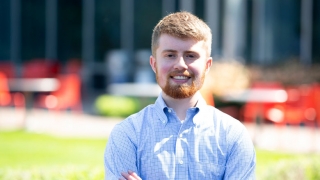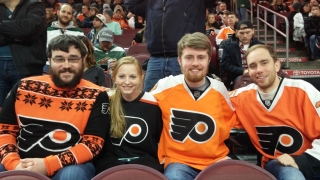Tetralogy of Fallot and Discontinuous Pulmonary Arteries: Zane's Story
Published on
Published on
At 3 days old, Zane underwent heart surgery to repair a complex combination of cardiac defects. Within days he needed a pacemaker implanted to keep his heart rhythm regular. Despite these early health challenges, Zane and his family refused to let his condition get in the way of an active life.
 "I grew up as a normal kid," Zane says. "I wrestled with my siblings, played outside, was on the tennis and soccer teams in high school, and have always enjoyed hiking and camping."
"I grew up as a normal kid," Zane says. "I wrestled with my siblings, played outside, was on the tennis and soccer teams in high school, and have always enjoyed hiking and camping."
Now 22, Zane is a pre-med student at West Chester University in Pennsylvania, with the goal of becoming a pediatric cardiologist like the physician who first identified his condition and has treated him ever since — Jack Rychik, MD, an attending cardiologist with the Cardiac Center at Children’s Hospital of Philadelphia (CHOP).
Zane appeared to be a healthy baby at birth. But as he and his mother, Sarah, were preparing to leave the hospital in Phoenixville, PA, she noticed his coloring had changed. She asked a nurse to listen to his heart as a precaution; a cousin had been born days before with a serious heart condition.
The nurse detected a slight heart murmur, which was confirmed by the attending physician. “They told us Zane needed to be looked at by a cardiologist at CHOP immediately,” remembers Zane’s father, Mark.
Zane was transported from Phoenixville to Bryn Mawr, where Dr. Rychik was consulted on Zane’s case and an echocardiogram was performed. After reviewing the echocardiogram images of Zane’s heart, Dr. Rychik diagnosed the baby with tetralogy of Fallot (TOF) and discontinuous pulmonary arteries. Zane had a complex combination of characteristics:
Because of the combination of Zane’s heart problems, Dr. Rychik told the family that he needed to be transferred to Children’s Hospital of Philadelphia for surgery. Medication was used to keep the PDA open until surgery, as Zane would lose blood flow to his left lung if the PDA closed before surgery.
An ambulance transported Zane to CHOP. When Zane was just 3 days old, he underwent open heart surgery with Thomas Spray, MD, then-Chief of CHOP’s Division of Cardiothoracic Surgery.
Dr. Spray closed the hole between the two ventricles with a patch and opened the pulmonary valve more fully, both as planned. To treat the narrowed pulmonary artery and PDA, Dr. Spray used an innovative technique during surgery. He cut the pulmonary artery in half, flipped it over the opening, sewed a patch on it, then flipped it back.
It worked. Zane came out of surgery with stronger circulation.
A new problem soon emerged. After the surgery, Zane developed heart block. A second procedure was done to implant a pacemaker, a small device that uses electrical pulses to control abnormal heart rhythms and prompt the heart to beat normally.
Once the pacemaker was implanted, Zane’s heart problems largely resolved. He was able to go home and lead a relatively normal life, with close monitoring and regular follow-up visits with Dr. Rychik. During Zane's first year of life, he needed two angioplasties, a catheterization used to widen constricted arteries and remove scar tissue.
In the 20 years since, Zane has only needed minor surgery to replace the pacemaker when the generator needed to be replaced.
For some children, complex cardiac conditions can impact their lives and affect everyday activities. That wasn't the case for Zane.
“Dr. Rychik told us he can do whatever he wants,” says Mark. “He told us not to baby him.”
To protect Zane's heart and pacemaker, a few activities were put off limits — waterskiing, weight lifting and rock climbing, for example — but none really interested Zane so he didn't care. Instead, he wrestled with his siblings, loved playing outdoors and joined his high school's tennis and soccer teams. Zane has also always enjoyed hiking, camping and ice skating.
 Now 22 years old, Zane looks back fondly to his early visits to CHOP.
Now 22 years old, Zane looks back fondly to his early visits to CHOP.
“I always have fun when I go to CHOP,” he says. “When I was little, I would play hide and seek in the exam room with Dr. Rychik. There were only a couple of places to hide, but he always played along and pretended to have a hard time finding me."
As Zane got older, he remembers how Dr. Rychik would "sit down with me and ask me how I was doing. He has always been genuinely interested.”
“And it wasn’t just Dr. Rychik,” Zane continues.
“Everyone at CHOP was so loving and nice to me. Most of the people in the Cardiac Center have known me since I was 2 or 3 years old. They are always happy to see me, and I can tell they really care.”
Dr. Rychik has followed Zane’s journey into adulthood with interest. He was pleased when Zane originally decided to go to seminary school, and equally delighted when Zane altered his path two years later and transferred to begin pre-med studies.
Zane now hopes to become a pediatric cardiologist like his mentor. “I am who I am because of Dr. Rychik.”